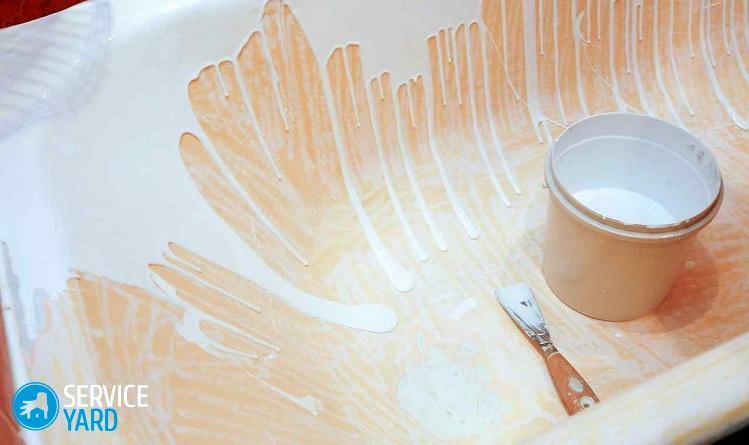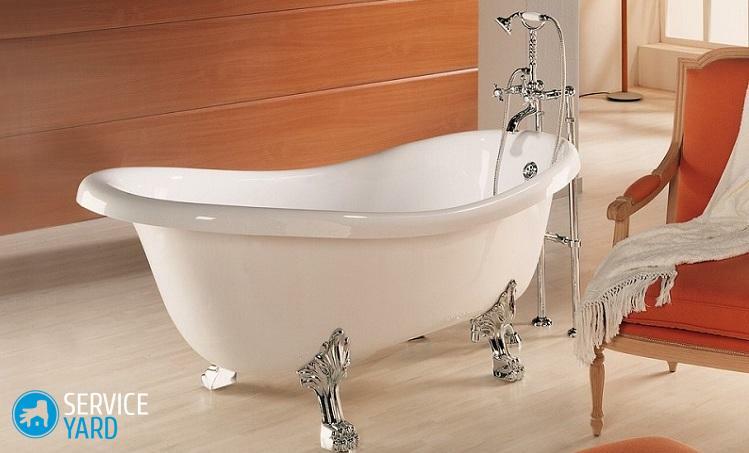
- The main properties of the cast-iron bath
- Features of enamel damage
- Reasons for the restoration of cast-iron baths
- Rules for the preparation of a bath for restoration
- The most popular ways of restoring a cast-iron bath
For many decades, such a shockproof, wear-resistant and durablesanitary ware, like a cast-iron bath. Previously, these items simply did not have any worthy alternative. But today all construction shops offer a huge selection of various acrylic and steel models, which are quite in demand. Nevertheless, cast iron always wins against the background of other products due to its remarkable performance properties, even though it is so expensive. But after ten years of use, the surface of the material begins to turn yellow and become covered with small cracks, so the restoration of the bath enamel in such cases is quite an up-to-date procedure. Today, we learn about the features and basic technologies for implementing this procedure.
to the contents ↑The main properties of the cast-iron bath
Today such baths are really the most popular due to their numerous properties and excellent characteristics. Naturally, they need adequate care, and often the restoration of a cast iron bath is the only way out.
Important! Produce these products through a casting method. This material in itself is complicated in terms of processing, since, for all its density and hardness, it is rather fragile. Most complications arise in the process of giving the alloy a curved or round shape, which is why the model and size range of these products is not so great as would be desirable for buyers.
The undeniable advantages of cast iron baths are:
- Wear resistance. Cast iron tanks for washing can withstand a rather long service life, more than 50 years. Throughout this period, their strength remains at the original level. Enamel is much spoiled before, but if the bath is repaired in time, you can completely put it in order.
- Low noise level. The walls of this bath reach a width of 8 mm, which is why they isolate sound well. When water is recruited into a container, the user does not experience any special discomfort.
- Can be easily repaired. You can restore the bath enamel even with your own hands. The work is done by enamelling, installing an acrylic liner or pouring acrylic.
- Slow cooling. This material has a low level of thermal conductivity, and it is due to this that the water inside the container remains warm for a long time.
Features of enamel damage
The enamel applied at the factory to the surface of a cast iron bath is considered to be sufficiently reliable and wear-resistant. But over time, it spoils because of too active operation, even if the recommendations of the manufacturer. Enamelling the bath with your own hands is the best option for restoring the top coating of cast iron. After a certain period of time, such defects can appear inside the bath:
- Yellowness. Gradually the snow-white enamel acquires an ugly yellowish shade, negatively affecting its appearance. This is due to constant contact with water with a high content of iron.
- Wipes. Due to the use of abrasive cleaners and too hard brushes, abrasions often appear on the surface of the baths.
- Chips. Minor enamel damage occurs as a result of accidental falling of heavy objects in the bath. Point impacts of medium strength cause the enamel to exfoliate from the cast iron.
- Cracks. Appear on the enamel cracks due to the aggravation of mechanical stress and temperature changes.
Reasons for the restoration of cast-iron baths
Most often people start to think about how to restore a bath for such common reasons:
- Financial question. Your favorite old bath has lost its appearance, but you can not afford to buy new plumbing in the near future.
- Temporary and removable housing. When a person rents an apartment for a while or plans to rent it out, naturally, spending money on a new bath does not make sense.
- Special layout. It happens that removing and dismantling an old bath is simply impossible. Of course, you can try to break it, but it's better to repair it after all.
Rules for preparing a bath for restoration
Before you restore a bath, you need to prepare its surface properly, otherwise you will not get a good result. There is preparation in several stages:
- Removal of rust. It is recommended to treat the surface with gentle solutions of acetic or oxalic acid. They need to be applied and held for half an hour, and then washed off. If the rust remains after this, the cleaning will have to be done mechanically.
- Grinding. Immediately after removing the rust, the bath is ground, for this purpose a drill, a bulgarian or sandpaper is used.
- Cracks and deep chips. These plots are wiped with automotive filler, then further polished.
- Degreasing. To do this, most commonly used baking soda or special means, which must be washed off with hot water after the treatment.
Once the bath completely dries:
- You need to remove the drain and overflow. Down under the sink put a container, where the paint will drain.
- Sand and fine dust is best cleaned with a vacuum cleaner.
- All surfaces adjacent to the bathtub should be covered with adhesive tape.
- Surface coating with acrylic or epoxy enamel provides mandatory primer application.
The most popular ways of restoration of the cast-iron bath
Most often in our time, a cast-iron bath is repaired with enamel, pouring with acrylic or installing an acrylic liner. Do a restoration by one method or another should only after the completion of the repair work, so as not to damage the updated layer. And now we will learn more about each method separately.
Enameling a cast-iron bath at home
This is the most affordable and easy-to-carry option for enamel restoration. For painting, you can use classic epoxy enamel or other more expensive and effective paint.
Important! The diluted epoxy mixtures are quite toxic and flammable, which is why the surface coating with enamel of this nature necessarily involves the use of protective equipment - rubber gloves and a respirator.
How to apply enamel on a cast iron bath:
- It is applied with a natural brush or a terry roller.
- It is necessary to start from the rim to the bottom, it is necessary to make sure that the paint is laid evenly, thinly.
- When the bath on the sides is already painted, you can proceed to the bottom. Where the layer is too thick, you need to smudge the paint a little.
- Apply epoxy enamel in three layers, then wait 15 minutes and check for streaks.
- Completely the bath will dry up only after some days, but experts recommend to wait not less than five days.
- After drying, it is necessary to polish the surface with a flannel flap with a drop of polishing paste.
 Advantages of this method of cast iron restoration:
Advantages of this method of cast iron restoration:
- Enamelling cost is low.
- Minimum amount of work associated with the dismantling.
Enamel defects:
- After a short period of time, the enamel turns yellow again.
- Paint stays on the surface for no more than five years.
- You can use the restored bathroom only after a week.
- The enamel can not hide the unevenness present in the factory floor.
Renewal of enamel with liquid acrylic with their own hands
Repair of an old bath with acrylic or "filling bath" has nothing to do with the previous version of the enamel. Moreover, the surface should be carefully prepared.
Important! After carrying out all the preparatory work the applied composition on the old enamel completely freezes, thereby forming a certain insert.
The technique of applying acrylic looks like this:
- So that cracks and chips do not appear on the already repaired surface, they are shpaklyuyut directly in front of the primer.
Important! It is better to use automotive filler based on fiberglass. It is applied to the damaged areas with a rubber spatula.
- Now a bucket of acrylic is opened. The composition is properly mixed with a drill, and for this you need to wear a special nozzle on it.
- The drain is closed with a disposable cup, and the bucket is put in the tub to the bottom.
- The finished mixture is poured into a small bowl.
- Begin the restoration should be from the sides, with all the acrylic poured on the surface of the bowl. Using a spatula, it is distributed at the corners and along the edge.
- After the mixture drains to the bottom, you will have blank areas. Acrylic rises with a spatula to them, neat movements from the bottom up.
- After the surface is completely filled, it is necessary to open the drain so that the acrylic residues leak into the substituted container.
- It takes at least 24 hours to completely dry this material.
Advantages of the "bath tub":
- Fast drying.
- Does not turn yellow with time.
- Durable finish.
- Even wet acrylic does not slip.
- Operation period is not less than 10 years.
Disadvantages of using acrylic:
- The technology itself for the restoration of a bath with acrylic is quite complicated. Therefore, a person engaged in this work must have certain skills and experience.
Bath recovery with acrylic liner
Restoration of old bathtubs with acrylic liner, in fact, nothing complicated does not represent itself. In the course of the work, a new plastic cup is pasted inside the bathtub, completely identical and repeating the shape of the old one. Manufacture of such inserts in factories, according to the current standards.
Important! The back side of such bowls, as a rule, is additionally reinforced with the help of fiberglass. A qualitative acrylic insert should have a thickness of at least 6 mm.
Process features
Prepare and restore the bath according to this technology is easy. In this case, it is not necessary to grind and clean the bath.

Installation technology:
- It is necessary to fill in cracks and chips.
- Then remove the overflow and drain.
- Now you need to remove the skirts adjacent to the bath.
- Carefully dismantle or cut off the ceramic tile elements with a diamond disc.
- The purchased insert should be marked, pruned and drilled in it for drain holes.
- Apply sealant around the overflow and drainage, and on the rest of the surface, where the liner will be fastened, special glue.
- Now carefully insert the acrylic insert into the bath, remove the excess silicone on all the holes, install decorative grilles.
- Fill the bath to the brim with cold water, leave for a day.
Advantages of using an acrylic liner:
- The surface is perfectly flat.
- Will last for at least 15 years.
- The aesthetic qualities of the liner are preserved for many years.
Disadvantages of bath restoration with acrylic liner:
- Surface is hypersensitive to mechanical damage.
- Liners often do not match the size of the bathtub.
- Additional demolition work is required.
- The high price of restoration, but if you do everything yourself, it will be cheaper.
As we can see, all the presented ways of restoration of the cast-iron bath are good in their own way, each has its own positive and negative sides. But in order to achieve the desired result, the main thing is to adhere to the clear technology of the work.



